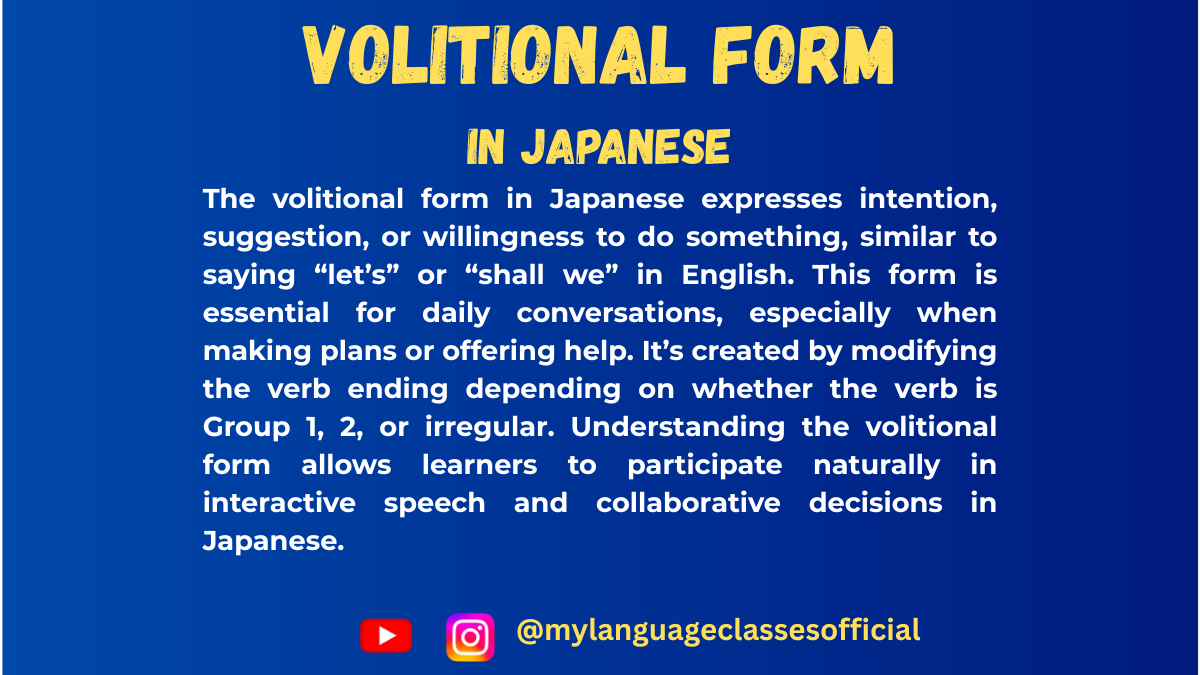Your cart is currently empty!
Understanding Volitional Form in Japanese

Volitional Form in Japanese
The volitional form in Japanese is a versatile and essential grammatical structure. It’s often used to express intentions, suggestions, or invitations. Think of it as the Japanese equivalent of saying, “Let’s” or “Shall we?” in English.
This post will break it down into two main categories: the informal volitional form and the polite volitional form, making it easy for learners of all levels to grasp and apply.
1. The Informal Volitional Form
The informal volitional form is used casually among friends, family, or people you’re close to. It’s the shorter, more relaxed version of suggesting something.
How to Form It
The structure depends on whether the verb is a う-verb or a る-verb. Here’s how you can form the volitional form:
- For う-verbs: Replace the final う sound with おう.
- Example:
- 行く (iku – to go) → 行こう (ikou – Let’s go)
- 飲む (nomu – to drink) → 飲もう (nomou – Let’s drink)
- Example:
- For る-verbs: Drop the る and add よう.
- Example:
- 食べる (taberu – to eat) → 食べよう (tabeyou – Let’s eat)
- 見る (miru – to see/watch) → 見よう (miyou – Let’s watch)
- Example:
- Irregular verbs: These don’t follow the usual patterns and need to be memorized:
- する (suru – to do) → しよう (shiyou – Let’s do)
- 来る (kuru – to come) → 来よう (koyou – Let’s come)
When to Use It
Use the informal volitional form in casual contexts:
- Planning something with friends:
- 映画を見よう! (Eiga o miyou! – Let’s watch a movie!)
- Deciding something for yourself:
- もっと頑張ろう。 (Motto ganbarou. – I’ll try harder.)
2. The Polite Volitional Form
For more formal situations, the polite volitional form is used. This is especially common in workplaces, public settings, or when speaking to superiors or strangers.
How to Form It
The polite volitional form follows a straightforward rule:
- Take the stem of the verb and add ましょう.
- Example:
- 行く (iku – to go) → 行きましょう (ikimashou – Let’s go)
- 食べる (taberu – to eat) → 食べましょう (tabemashou – Let’s eat)
When to Use It
Use the polite volitional form in formal or respectful contexts:
- Inviting someone politely:
- 一緒に昼ご飯を食べましょうか? (Issho ni hiru gohan o tabemashou ka? – Shall we have lunch together?)
- Offering a suggestion in a business setting:
- 次のステップを考えましょう。 (Tsugi no suteppu o kangaemashou. – Let’s think about the next step.)
3. Key Differences Between Informal and Polite Forms
| Aspect | Informal Volitional Form | Polite Volitional Form |
|---|---|---|
| Tone | Casual | Formal/Respectful |
| Ending | おう/よう | Verb stem + ましょう |
| Usage Context | Friends, family | Business, public, formal |
4. Practice Makes Perfect!
Here are a few sentences to test your understanding. Try converting them into both informal and polite volitional forms:
- 泳ぐ (oyogu – to swim)
- 話す (hanasu – to talk)
- 勉強する (benkyou suru – to study)
Answers:
- 泳ぐ: 泳ごう / 泳ぎましょう
- 話す: 話そう / 話しましょう
- 勉強する: 勉強しよう / 勉強しましょう
By mastering the volitional form, you’ll be well on your way to expressing intentions and making suggestions naturally in Japanese. Practice using these forms in conversations, and soon they’ll become second nature. 頑張りましょう! (Ganbarimashou! – Let’s do our best!)
If you enjoyed this lesson, be sure to check out more posts like this on my blog at My Language Classes. Don’t forget to subscribe my YouTube channel and follow me on Instagram for the latest language learning tips and lessons. Leave a comment below to share your thoughts, or ask any questions you have about nouns.
Happy learning! 😊
📚 Continue Learning Japanese
Vikas Kumar is a dedicated language educator, content creator, and digital entrepreneur, best known as the co-founder of My Language Classes and The Curious Mind. With a strong focus on helping learners achieve fluency in English, Spanish, and Japanese, he has guided audiences worldwide through a diverse range of resources, including in-depth blog articles, engaging YouTube tutorials, and comprehensive Books.
Through My Language Classes, Vikas has built a thriving multilingual learning platform that serves students, travelers, and professionals eager to master communication skills for personal, academic, and professional success. His expertise extends to exam preparation for internationally recognized certifications such as JLPT, DELE, IELTS, and TOEFL, enabling learners to achieve tangible, career-enhancing results.
As the founder of The Curious Mind, he also explores broader areas of knowledge, including self-help, motivation, modern learning strategies, and thought-provoking insights on life and personal growth. His work blends practical teaching methods with a deep understanding of learner psychology, making complex concepts accessible and engaging.
Driven by a mission to make high-quality education accessible to all, Vikas continues to expand his reach across multiple platforms, including YouTube, blogs, eBooks, and social media communities, inspiring thousands to learn, grow, and embrace lifelong learning.


Leave a Reply